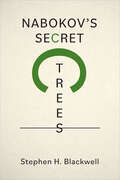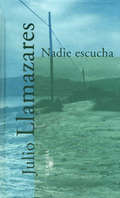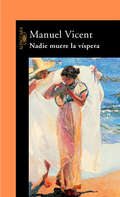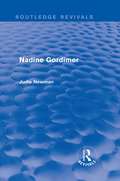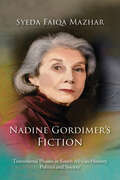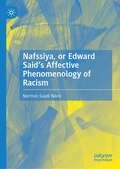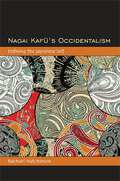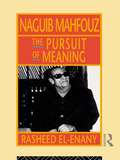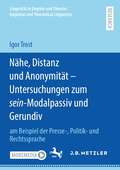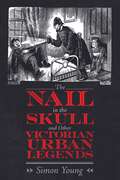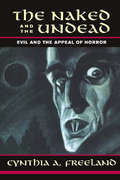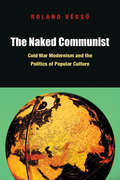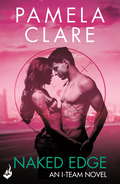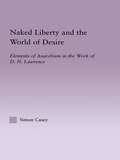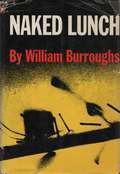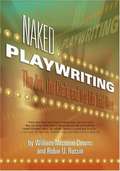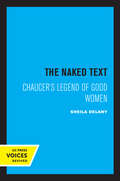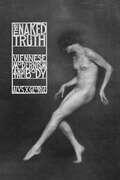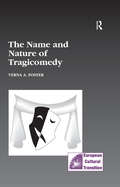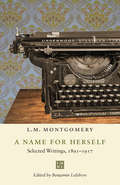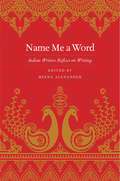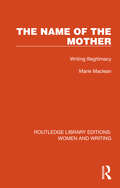- Table View
- List View
Nabokov’s Secret Trees
by Stephen H. BlackwellIn nearly all his literary works, Vladimir Nabokov inscribed networks of trees to create meaningful patterns of significance around one or more of his passionate interests – in consciousness, memory, creativity, epistemology, ethics, and love, with a deep connection to nature serving as a constant undercurrent. Nabokov’s Secret Trees explores this neglected area of his art, one that positions nature as a hidden but vital core of his work. The book presents an entirely new, previously unsuspected Nabokov, one who crafts intricate patterns of arboreal imagery lurking behind his often-baroque psychological narratives. It reveals how Nabokov activates arboreal potentials by exploring the hidden ubiquity of trees, their essence as complex natural phenomena, and their role as quiet presences that have accompanied and fostered human civilization and art since their beginnings. The book uncovers how trees offer a rich and intricate field for structural, semantic, allusive, and metaphorical exploration. Based on the published corpus as well as archival materials, Nabokov’s Secret Trees demonstrates that trees not only populate Nabokov’s art in stunning, yet furtive, abundance, but also as mysterious natural entities, directly animating his works’ worlds and his readers’ experience of them.
Nachhaltiges Personalmanagement als Schlüsselfaktor für erfolgreiches Wirtschaften: Eine linguistische Diskursanalyse ausgewählter Unternehmenstexte und Printmedien (Sprache und Wirtschaft)
by Elisabeth GeursenMit diesem Open-Access-Buch liefert Elisabeth Geursen erstmals Erkenntnisse zum Nachhaltigkeitsbegriff im Personalmanagement, auf den mit „Human Capital“ oder „Human Ressource“ referiert wird, mithilfe primär linguistischer Methoden. Der Nachhaltigkeitsidee wird im deutschsprachigen und internationalen Kontext gesellschaftspolitische Relevanz zugewiesen. Geursen präsentiert im Bereich des gesellschaftlichen Diskurses um nachhaltiges Wirtschaften im Personalbereich prominente Themenkomplexe und deren diskurspezifische Verhandlung in ihrer zeitlichen Entwicklung über einen Zeitraum von 20 Jahren. Hervorzuheben ist der kontrastive Ansatz: Es wird die Themenentwicklung in den Geschäfts- und Nachhaltigkeitsberichten von drei branchenspezifischen Unternehmen, die hinsichtlich ihrer Nachhaltigkeitsaktivitäten besondere massenmediale Aufmerksamkeit erhalten, sowie in überregionalen Printmedien untersucht. Aus den Analyseergebnissen leitet Geursen Handlungsempfehlungen für Akteure ab und demonstriert damit einen starken Praxisbezug. Geursen gelingt eine Erweiterung bisheriger Nachhaltigkeitsforschung in einem wirtschaftswissenschaftlichen Themenfeld durch eine operationalisierte, theoretisch-fundierte diskurslinguistische und framebezogene Methodik (hier dem Verfahren nach Konerding entsprechend).
Nadie escucha (Alfaguara Ser.)
by Julio LlamazaresOpiniones, reportajes y artículos de viaje que revelan el pensamiento y la experiencia de un escritor que ha dado a la literatura española contemporánea algunas de sus mejores páginas. «Últimamente hay demasiado ruido. Si de alguna manera tuviera que definir la época en la que estamos viviendo, es como un tiempo en el que hay tanto ruido que nadie escucha a nadie, ni siquiera a sí mismo.» En medio de esta constatación escéptica, la prosa tranquila, amable y socarrona de Julio Llamazares resulta ser un lugar de descanso, un oasis ameno donde la palabra del autor se confunde con las reflexiones del lector, un regalo para todos aquellos capaces de escuchar a los demás sin dejar por ello de oírse a sí mismos. A esos lectores dedica el autor Nadie escucha.
Nadie muere la víspera
by Manuel VicentManuel Vicent recopila en Nadie muere en la víspera 150 textos sobre filosofía de vida y su profesión. «Este libro no es solo una selección de artículos que he escrito en El País a lo largo de los últimos cuatro años. De este trabajo ha sido extraído un núcleo de sensaciones, historias y visiones hasta formar un dietario, que puede leerse como una forma de ser, de pensar, de creer y de vivir: un trayecto hacia una salvación personal en la que cualquier lector puede participar. De todo lo que nos ocurre en este camino de la vida he tratado de escoger esos momentos que nos hacen felices, perplejos, escépticos y expertos en pequeños placeres. Las mismas palabras que fueron embarcadas en un periódico tienen ahora en el libro una lectura distinta y una trama nueva cuyo argumento es este: hasta el día de la muerte todos somos inmortales cazadores de mariposas.»Manuel Vicent
Nadine Gordimer: A Casebook (Routledge Revivals)
by Judie NewmanInternational in her appeal, Nadine Gordimer is an original and accomplished novelist whose works have found literary and popular recognition. In this critical study, first published in 1988 and the first by a woman, Judie Newman discusses Gordimer’s novels, including A Sport of Nature. Gordimer’s writing is both political committed and formally innovative, confronting subject matter of great contemporary interest and at the same time seeking out narrative forms that combine European and indigenous culture. Her novels are sensitive to their context, while also offering an important contribution to postmodernist reassessments of narrative poetics, and a challenge to European conceptions of the novel. Judie Newman places particular emphasis on Gordimer’s searching investigation of the relation of gender to genre, and explores other major concerns such as the crisis of liberal values, the nature of historical consciousness, racism, sexual politics, and the psychopathology of power. Her study combines close literary analysis with a wide-ranging exploration of ideas, showing clearly how the artist can contribute to contemporary debate.
Nadine Gordimer's Fiction: Transitional Phases in South African History, Politics and Society
by Syeda Faiqa MazharNadine Gordimer’s Fiction is a major study of the life and writings of Nadine Gordimer, a towering figure in the literary and cultural life of South Africa in the late 20th and early 21st centuries, recognised for her fiction through several prizes, most notably the 1991 Nobel Prize for Literature. It has the makings of a guide, taking the reader through the complexities in Gordimer’s life, literature, and society, backed by academic research (doctoral and postdoctoral) and informed by Dr. Mazhar’s study visit to South Africa, including a face-to-face interview with Gordimer. The reader gets a rich picture mediated by the author’s own intellectual journey from Pakistan – the country of her birth – and the United Kingdom. Dr. Mazhar maps the complexities of colonialism in South Africa and beyond in different forms, most notably in the legislated discrimination based on race/ethnicity, Apartheid (1948–1994). Covering the literary writings and political activism of Gordimer both during and after Apartheid, the book provides the reader with a detailed account of individual works of fiction, and vistas of critical thought and action that serve as their source and backdrop. Dr. Mazhar draws on the cultural theories of Homi Bhabha, especially on the notion of The Third Space, a fictional space/borderland between social and political polarisations, which allows for reflection, refinement, and re-action that is transformational and psychologically uplifting. She demonstrates that Gordimer takes her characters through such spaces, which allow for a transformational experience that leads to perspectives/realisations that were missing as a result of constraints that were externally imposed by law and tradition and interiorised as a survival mode. Dr. Mazhar concludes that Gordimer gracefully articulates her vision for a world free of complexities, which one must strive for. Although the book presents the academic analysis of Gordimer‘s fiction and the memoir as separate parts, there are organic connections between the two, which link the social ethos, political struggles, varied ideological perspectives, and ethnic and trans-ethnic identities from which Gordimer draws her subjects and their lives and depicts them through appropriate narrative techniques. Nadine Gordimer’s Fiction is a welcome addition to books on author studies, literary criticism, and South African culture and society. It offers excellent material for both academic and non-academic readers. The style of writing used in the book is clear and simple, yet powerful. This can help the reader to appreciate the enormous achievement of Gordimer, which has established her as a major literary figure in South Africa and beyond. Dr. Balasubramanyam Chandramohan PhD (Shef), FHEA, Senior Research Fellow, Institute of Commonwealth Studies, School of Advanced Study, University of London
Nadine Gordimer's July's People: A Routledge Study Guide (Routledge Guides to Literature)
by Brendon NichollsNadine Gordimer is one of the most important writers to emerge in the twentieth century. Her anti-Apartheid novel July's People (1981) is a powerful example of resistance writing and continues even now to unsettle easy assumptions about issues of power, race, gender and identity. This guide to Gordimer's compelling novel offers: an accessible introduction to the text and contexts of July's People a critical history, surveying the many interpretations of the text from publication to the present a selection of new and reprinted critical essays on July's People, providing a range of perspectives on the novel and extending the coverage of key approaches identified in the critical survey cross-references between sections of the guide, in order to suggest links between texts, contexts and criticism suggestions for further reading. Part of the Routledge Guides to Literature series, this volume is essential reading for all those beginning detailed study of July's People and seeking not only a guide to the novel, but a way through the wealth of contextual and critical material that surrounds Gordimer's text.
Nafssiya, or Edward Said's Affective Phenomenology of Racism
by Norman Saadi NikroThis book adapts the Arabic term nafsiyya to trace the phenomenological contours of Edward Said’s analysis of the affective dimensions of colonial and imperial racism. Reflecting on what he called his “colonial education,” Said rendered his Palestinian/Arab background and experience of racism an enabling component of his academic work. The argument focuses on his “personal dimension” section in his introduction to his famous volume Orientalism, discussing key notions of Said’s oeuvre—such as ‘elaboration,’ ‘circumstance,’ ‘humanism,’ ‘worldliness,’ ‘inventory,’ and ‘critical consciousness.’ Providing a lengthy study of his earlier and somewhat neglected Beginnings: Intention and Method, the book discusses the significance of the style of the essay as a key component of what the author calls Said’s interventionist brand of scholarship. The final chapter outlines how Said’s oeuvre can be situated in a genealogy of a radical phenomenology of racism that emerged from the colonies.
Nagai Kafū's Occidentalism: Defining the Japanese Self
by Rachael HutchinsonNagai Kafū (1879–1959) spent more time abroad than any other writer of his generation, firing the Japanese imagination with his visions of America and France. Applying the theoretical framework of Occidentalism to Japanese literature, Rachael Hutchinson explores Kafū's construction of the Western Other, an integral part of his critique of Meiji civilization. Through contrast with the Western Other, Kafū was able to solve the dilemma that so plagued Japanese intellectuals—how to modernize and yet retain an authentic Japanese identity in the modern world. Kafū's flexible positioning of imagined spaces like the "West" and the "Orient" ultimately led him to a definition of the Japanese Self. Hutchinson analyzes the wide range of Kafū's work, particularly those novels and stories reflecting Kafū's time in the West and the return to Japan, most unknown to Western readers and a number unavailable in English, along with his better-known depictions of Edo's demimonde. Kafū's place in Japan's intellectual history and his influence on other writers are also discussed.
Naguib Mahfouz: The Pursuit of Meaning (Arabic Thought and Culture)
by Rasheed El-EnanyFirst Published in 2004. Routledge is an imprint of Taylor & Francis, an informa company.
Nähe, Distanz und Anonymität - Untersuchungen zum sein-Modalpassiv und Gerundiv: am Beispiel der Presse-, Politik- und Rechtssprache (Linguistik in Empirie und Theorie/Empirical and Theoretical Linguistics)
by Igor TrostUntersuchungsgegenstand sind die Grammatik, die Modal-, Temporal- und Aspekt-Semantik, die Pragmatik und die Funktion der beiden modalpassivischen Konstruktionen sein-Modalpassiv und Gerundiv im Deutschen am Beispiel von drei für den Gebrauch dieser beiden Konstruktionen einschlägigen Domänen, nämlich der Presse-, Politik- und Rechtssprache. Von ihrer syntaktisch-semantischen und textlinguistischen Grundausrichtung schlägt die korpusbasierte Arbeit den Bogen zur variationslinguistischen Pragmatik, linguistischen Sprachgebrauchsanalyse und Sprachgebrauchskritik.
The Nail in the Skull and Other Victorian Urban Legends
by Simon YoungWinner of the 2023 Brian McConnell Book Award from the International Society for Contemporary Legend ResearchIn the last fifty years, folklorists have amassed an extraordinary corpus of contemporary legends including the “Choking Doberman,” the “Eaten Ticket,” and the “Vanishing Hitchhiker.” But what about the urban legends of the past? These legends and tales have rarely been collected, and when they occasionally appear, they do so as ancestors or precursors of the urban legends of today, rather than as stories in their own right. In The Nail in the Skull and Other Victorian Urban Legends, Simon Young fills this gap for British folklore (and for the wider English-speaking world) of the 1800s. Young introduces seventy Victorian urban legends ranging from “Beetle Eyes” to the “Shoplifter’s Dilemma” and from “Hands in the Muff” to the “Suicide Club.” While a handful of these stories are already known, the vast majority have never been identified, and they have certainly never received scholarly treatment. Young begins the volume with a lengthy introduction assessing nineteenth-century media, emphasizing the importance of the written word to the perpetuation and preservation of these myths. He draws on numerous nineteenth-century books, periodicals, and ephemera, including digitized newspaper archives—particularly the British Newspaper Archive, an exciting new hunting ground for folklorists. The Nail in the Skull and Other Victorian Urban Legends will appeal to an academic audience as well as to anyone who is interested in urban legends.
The Naked and the Undead: Evil and the Appeal of Horror
by Cynthia A. FreelandHorror is often dismissed as mass art or lowbrow entertainment that produces only short-term thrills. Horror films can be bloody, gory, and disturbing, so some people argue that they have bad moral effects, inciting viewers to imitate cinematic violence or desensitizing them to atrocities. In The Naked and the Undead: Evil and the Appeal of Horror, Cynthia A. Freeland seeks to counter both aesthetic disdain and moral condemnation by focusing on a select body of important and revealing films, demonstrating how the genre is capable of deep philosophical reflection about the existence and nature of evil-both human and cosmic. In exploring these films, the author argues against a purely psychoanalytic approach and opts for both feminist and philosophical understandings. She looks at what it is in these movies that serves to elicit specific reactions in viewers and why such responses as fear and disgust are ultimately pleasurable. The author is particularly interested in showing how gender figures into screen presentations of evil. The book is divided into three sections: Mad Scientists and Monstrous Mothers, which looks into the implications of male, rationalistic, scientific technology gone awry; The Vampire’s Seduction, which explores the attraction of evil and the human ability (or inability) to distinguish active from passive, subject from object, and virtue from vice; and Sublime Spectacles of Disaster, which examines the human fascination with horror spectacle. This section concludes with a chapter on graphic horror films like The Texas Chainsaw Massacre. Written for both students and film enthusiasts, the book examines a wide array of films including: The Silence of the Lambs, Repulsion, Frankenstein, The Fly, Dead Ringers, Alien, Bram Stoker’s Dracula, Interview with the Vampire, Frenzy, The Shining, Eraserhead, Hellraiser, and many others.
The Naked Communist: Cold War Modernism and the Politics of Popular Culture
by Roland VégsőThe Naked Communist argues that the political ideologies of modernity were fundamentally determined by four basic figures: the world, the enemy, the secret, and the catastrophe. While the “world” names the totality that functioned as the ultimate horizon of modern political imagination, the three other figures define the necessary limits of this totality by reflecting on the limits of representation.The book highlights the enduring presence of these figures in the modern imagination through detailed analysis of a concrete historical example: American anti-Communist politics of the 1950s. Its primary objective is to describe the internal mechanisms of what we could call an anti- Communist “aesthetic ideology.” The book thus traces the way anti-Communist popular culture emerged in the discourse of Cold War liberalism as a political symptom of modernism. Based on a discursive analysis of American anti-Communist politics, the book presents parallel readings of modernism and popular fiction from the 1950s (nuclear holocaust novels, spy novels, and popular political novels) in order to show that, despite the radical separation of the two cultural fields, they both participated in a common ideological program.
Naked Edge: I-Team 4 (I-Team #4)
by Pamela ClareFans of Suzanne Brockmann, Maya Banks, Christy Reece, Julie Ann Walker and Cindy Gerard will adore Pamela Clare's expertly plotted romantic suspense series, which sets the pages alight with sizzling chemistry. For tension, thrills, romance and passion take a spin with the I-Team.The day Navajo journalist Katherine James met Gabriel Rossiter, the earth literally moved beneath her feet when he saved her from a rockslide. So she is crushed when she recognizes her rescuer among the law enforcement officers throwing her and her friends off Mesa Butte, land they consider sacred. Gabe swore he would never again lose himself to a woman. But the attraction he feels to Kat is undeniable. And, appalled by his orders, he's determined to get to the bottom of events at Mesa Butte. But asking questions can be dangerous - almost as dangerous as risking one's heart. Soon Kat and Gabe's passion for the truth - and each other - makes them targets for those who would do anything, even kill, to keep Native Americans off their sacred land...Sexy. Thrilling. Unputdownable. Take a wildly romantic ride with Pamela Clare's I-Team: Extreme Exposure, Hard Evidence, Unlawful Contact, Naked Edge, Breaking Point, Striking Distance.
Naked In Baghdad
by Anne GarrelsAs National Public Radio's senior foreign correspondent, Anne Garrels has covered conflicts in Chechnya, Bosnia, Kosovo, Afghanistan, and elsewhere. She is renowned for direct, down-to-earth, insightful reportage, and for her independent take on what she sees. One of only sixteen non-embedded American journalists who stayed in Baghdad's now-legendary Palestine Hotel throughout the American invasion of Iraq, she was at the very center of the storm. Naked in Baghdad gives us the sights, sounds, and smells of our latest war with unparalleled vividness and immediacy. Garrels's narrative starts with several trips she made to Baghdad before the war, beginning in October 2002. At its heart is her evolving relationship with her Iraqi driver/minder, Amer, who becomes her friend and confidant, often serving as her eyes and ears among the populace and taking her where no other reporter was able to penetrate. Amer's own strong reactions and personal dilemma provide a trenchant counterpoint to daily events. The story is also punctuated by e-mail bulletins sent by Garrels's husband, Vint Lawrence, to their friends around the world, giving a private view of the rough-and-tumble, often dangerous life of a foreign correspondent, along with some much-needed comic relief.
Naked Liberty and the World of Desire: Elements of Anarchism in the Work of D.H. Lawrence (Studies in Major Literary Authors #20)
by Simon CaseyIn this new and original study, Simon Casey explores the long-neglected link between D. H. Lawrence and philosophical anarchism. Focusing on the writings of some of the major anarchists-with particular emphasis on Stirner, Godwin, Bakunin and Thoreau-this book argues that the conceptual parallels between Lawrence and anarchism are strong and extensive and that reading Lawrence within the context of this tradition significantly enhances any understanding of his work. Lawrence's faith in the essential decency of human nature, his forceful defense of individual liberty, and his intolerance of all forms of domination and control all reflect the essential features of anarchism. Naked Liberty and the World of Desire looks at where these attitudes find explicit articulation in Lawrence's essays, poems, and letters, and shows how they are illustrated in his major works of fiction.
Naked Lunch
by William S. BurroughsDelirious, nonlinear ravings of a junkie in hell. Also includes excerpts from the Boston trial where it was declared not obscene in 1966.
Naked Playwriting: The Art, the Craft, and the Life Laid Bare
by William Missouri Downs Robin U. RussinOffers a playwriting course, from developing a theme through plotting and structuring a play, developing characters, creating dialog, formatting the script, and applying methods that aid the actual writing and rewriting processes. This book also provides guidance on marketing and submitting play scripts for both contests and production.
The Naked Text: Chaucer's Legend of Good Women
by Sheila DelanyA sequel to her seminal book on Chaucer’s House of Fame, Sheila Delany’s elegant and innovative study of Chaucer’s Legend of Good Women explores what it meant to be a reader and a writer, and to be English and a courtier, in the late fourteenth century. The richness of late medieval art, philosophy, and history are powerfully brought to bear on one of Chaucer’s most controversial works. So too are the insights of modern critical theory—semiotics, historicism, and gender studies especially—making this a unique achievement in medieval and Chaucerian studies. Delany’s strikingly original readings of Chaucer’s Orientalism, his sexual wordplay, his theological attitudes, and his treatment of sex and gender have given us a Chaucer for our time. This title is part of UC Press's Voices Revived program, which commemorates University of California Press’s mission to seek out and cultivate the brightest minds and give them voice, reach, and impact. Drawing on a backlist dating to 1893, Voices Revived makes high-quality, peer-reviewed scholarship accessible once again using print-on-demand technology. This title was originally published in 1994.
The Naked Truth: Viennese Modernism and the Body
by Alys X. GeorgeUncovers the interplay of the physical and the aesthetic that shaped Viennese modernism and offers a new interpretation of this moment in the history of the West. Viennese modernism is often described in terms of a fin-de-siècle fascination with the psyche. But this stereotype of the movement as essentially cerebral overlooks a rich cultural history of the body. The Naked Truth, an interdisciplinary tour de force, addresses this lacuna, fundamentally recasting the visual, literary, and performative cultures of Viennese modernism through an innovative focus on the corporeal. Alys X. George explores the modernist focus on the flesh by turning our attention to the second Vienna medical school, which revolutionized the field of anatomy in the 1800s. As she traces the results of this materialist influence across a broad range of cultural forms—exhibitions, literature, portraiture, dance, film, and more—George brings into dialogue a diverse group of historical protagonists, from canonical figures such as Egon Schiele, Arthur Schnitzler, Joseph Roth, and Hugo von Hofmannsthal to long-overlooked ones, including author and doctor Marie Pappenheim, journalist Else Feldmann, and dancers Grete Wiesenthal, Gertrud Bodenwieser, and Hilde Holger. She deftly blends analyses of popular and “high” culture, laying to rest the notion that Viennese modernism was an exclusively male movement. The Naked Truth uncovers the complex interplay of the physical and the aesthetic that shaped modernism and offers a striking new interpretation of this fascinating moment in the history of the West.
The Name and Nature of Tragicomedy (Studies in European Cultural Transition #18)
by Verna A. FosterFocusing on European tragicomedy from the early modern period to the theatre of the absurd, Verna Foster here argues for the independence of tragicomedy as a genre that perceives and communicates human experience differently from the various forms of tragedy, comedy, and the drame (serious drama that is neither comic nor tragic). Foster posits that, in the sense of the dramaturgical and emotional fusion of tragic and comic elements to create a distinguishable new genre, tragicomedy has emerged only twice in the history of drama. She argues that tragicomedy first emerged and was controversial in the Renaissance; and that it has in modern times replaced tragedy itself as the most serious and moving of all dramatic genres. In the first section of the book, the author analyzes the name 'tragicomedy' and the genre's problems of identity; then goes on to explore early modern tragicomedies by Shakespeare, Beaumont and Fletcher, and Massinger. A transitional chapter addresses cognate genres. The final section of the book focuses on modern tragicomedies by Ibsen, Chekhov, Synge, O'Casey, Williams, Ionesco, Beckett and Pinter. By exploring dramaturgical similarities between early modern and modern tragicomedies, Foster demonstrates the persistence of tragicomedy's generic markers and provides a more precise conceptual framework for the genre than has so far been available.
A Name for Herself: Selected Writings, 1891–1917 (The L.M. Montgomery Library)
by L. M. Montgomery Benjamin LefebvreYears before she published her internationally celebrated first novel, Anne of Green Gables, L.M. Montgomery (1874–1942) started contributing short works to periodicals across North America. While these works consisted primarily of poems and short stories, she also experimented with a wider range of forms, particularly during the early years of her career, at which point she tested out several authorial identities before settling on the professional moniker "L.M. Montgomery." A Name for Herself: Selected Writings, 1891–1917 is the first in a series of volumes collecting Montgomery’s extensive contributions to periodicals. Leading Montgomery scholar Benjamin Lefebvre discusses these so-called miscellaneous pieces in relation to the works of English-speaking women writers who preceded her and the strategies they used to succeed, including the decision to publish under gender-neutral signatures. Among the highlights of the volume are Montgomery’s contributions to student periodicals, a weekly newspaper column entitled "Around the Table," a long-lost story narrated first by a woman trapped in an unhappy marriage and then by the man she wishes she had married instead, and a new edition of her 1917 celebrity memoir, "The Alpine Path." Drawing fascinating links to Montgomery’s life writing, career, and fiction, this volume will offer scholars and readers alike an intriguing new look at the work of Canada’s most enduringly popular author.
Name Me a Word: Indian Writers Reflect on Writing
by Meena AlexanderA wide-ranging anthology of twentieth-century and contemporary writing from India and the Indian diaspora, curated by a distinguished scholar and poet Internationally renowned scholar, poet, and essayist Meena Alexander brings together leading twentieth- and twenty-first-century voices from India and the diaspora in this anthology. Contributors include English-language luminaries such as R. K. Narayan, Salman Rushdie, and Arundhati Roy and powerful writers in Indian languages such as U. R. Ananthamurthy, Mahasweta Devi, and Lalithambika Antherjanam. This book will make a thoughtful gift for poetry and fiction enthusiasts and fans of Indian literature, as well as an ideal volume for academics introducing writers from the subcontinent.
The Name of the Mother: Writing Illegitimacy (Routledge Library Editions: Women and Writing)
by Marie MacleanIn this original and highly accomplished study, first published in 1994, Marie Maclean studies the writings of social rebels and explores the relationship between their personal narratives and illegitimacy. The case studies which Maclean examines fall into four groups: those which stress alternative family structures and ‘female genealogies’; those which pair female illegitimacy and revolution; those which question the deliberate refusal of the name of the father by the legitimate; those which study the revenge of genius on the society which excludes it. Skilfully interweaving feminist theory, French literary criticism, social and cultural history, deconstruction and psychoanalytic theory, Maclean traces the place of these personal narratives of illegitimacy in history and their use in theory, from Elizabeth I to Freud, Sartre and Derrida. The Name of the Mother will be of vital interest and importance to any student of critical theory, feminist philosophy, French or cultural studies.
